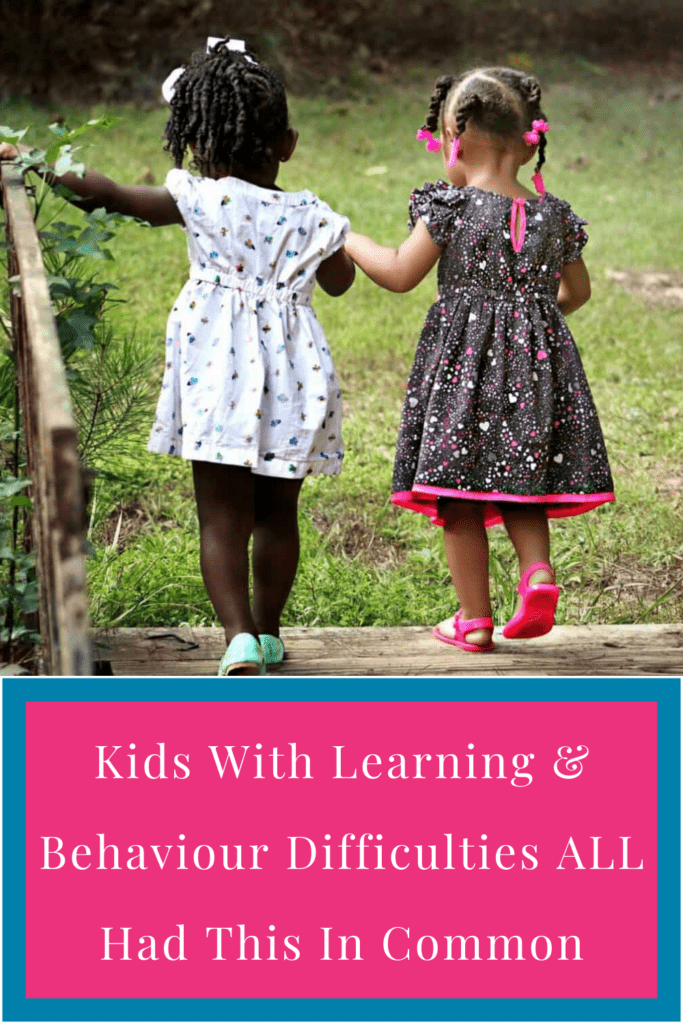I get really excited when I do a screening on a child who is struggling and find that there are clear areas of underdevelopment in the brain or areas of disconnection.
Parents kind of think I’m crazy because for them this is really scary. I get it. Nobody’s debating whether the brain is an important organ.
… and moms love to find ways to feel guilty or blame themselves for why their children has these disconnections or imbalances.
I was that mom not so long ago too.
Old Beliefs Die Hard About the Brain
We wouldn’t even have that awful feeling of doom if we weren’t all so hardwired to think the brain is like a machine and it really can’t be changed.
Neuroscience has shown otherwise for over 70-years and yet it’s only finally made headlines in the last 5-10 years. This stubborn myth about the brain is why so many in education continue to rely on compensations like meds, IEPs and tutoring as a permanent solution rather than corrective therapies.
A big part of my role is helping moms and kids who feel powerless to understand that the brain can change. This is why a recent study made my life a lot easier.
Largest Study Finds All Kids with Learning & Behavioural Challenges Has Retained Primitive Reflexes
The largest study ever done on children with behavioural and learning difficulties (over 2000 kids) under the direction of Dr. Robert Melillo found that ALL of the kids had retained primitive reflexes.
If you’re not familiar with retained primitive reflexes – let me give you the quick and fast explanation.
What are Primitive Reflexes?
Primitive reflexes are one of the most overlooked causes of Learning Disabilities and ADHD – even more so than the role of nutrition.
They develop in the brain stem before birth.
They require no thought
They are not taught.
They are instinctual.
They are a group of nerve connections linked to the nervous system and they are an involuntary response to a stimulus.
The Cute Things Your Baby Does…
You might remember when your child was a baby, and you would place your finger in the palm of their hand they would wrap all their tiny fingers around your finger. It’s heart melting.
That is a primitive reflex. Your infant has many primitive reflexes.
Another example is when you stroke your baby’s cheek, and they turn their head and ‘root’ in search of a nipple in order to feed. This is called the rooting reflex.
Primitive Reflexes have two purposes:
1) Assist with survival since a baby’s central nervous system is immature
2) Assist with movement since early infant movements are what develops the lower brain levels.
When children have a weak foundation and those lower brain levels are not well developed, they will without a doubt suffer from poor higher order brain skills like reasoning, planning, organizing, processing speed, cognition, focus and emotional regulation.
The Problem When Primitive Reflexes Don’t Disappear
These reflexes should integrate into the nervous system after they have served their purpose, but they may not because of:
- Insufficient tummy time
- Trauma
- Head injury
- Environmental toxicity such as exposure to chemicals and heavy metals
- Serious illness.
Retained Reflexes Affects Real Life Skills
If the reflex is retained, it will hinder proper brain development and make it more difficult for your child to access their cortex which is where higher order thinking occurs.
We often hear about executive functioning – this is where executive functioning occurs.
Skills like decision making, reasoning, planning, organization, emotional regulation, impulse control and critical thinking all occur in the higher brain levels known as the cortex.
… like Pop-Up Ads That Won’t Let You Get to the Website
I think of retained primitive reflexes like an instrument that holds it tune too long and drowns out the rest of the band or one of those pop ups that appear when you’re trying to look at a website.
You know how some of ads or pop-ups are so difficult and won’t go away – that’s a retained reflex. It prevents your child from accessing or optimally using the part of their brain that they need in order to optimally perform.
Retained Reflexes Block Easy Access to the Higher Brain Levels
When these reflexes don’t disappear (AKA integrate into the nervous system) it impedes the development of higher brain levels and ultimately affects the organization of your child’s brain.
When primitive reflexes don’t disappear, your child might have issues with balance, coordination of fine and gross motor skills, poor eye tracking, poor impulse control, difficulty sitting still and even aggression.
What it boils down to is that certain areas of their brain are not fully developed and that other areas are not well connected with one another, so they are not communicating well.
The More Reflexes that are Retained, the More Severe the Learning & Behaviour Difficulties
Dr. Melillo’s study confirmed two important findings:
1) All the children in the study group had retained primitive reflexes
2) The more reflexes that are retained, the more severe the behaviour and learning difficulties since more areas of the brain are affected.
The Brain Can Change, Retained Reflexes Can Be Integrated
After a 12-week program that incorporated primitive reflex integration, hemispheric brain balancing and the use of technology like interactive metronome not only were the retained primitive reflexes significantly reduced or completely integrated, performance in cognition, language, mathematical abilities, behaviour and motor skills also significantly improved.
There is not a doubt in my mind that the study group will continue to improve if they continue the exercises. After six months of similar interventions, many of my clients have increased several grade levels, been able to go off medication under the supervision of their doctor, many no longer required an IEP and several even completely lost their diagnosis of ADHD, dyslexia or a learning disability.
Demystifying Learning & Behaviour Difficulties
The important highlight of this study for me is that learning and behavioural difficulties are not the mysterious ‘boogey-man’ or stroke of bad luck that we think they are.
This is not the first study to illustrate the connection between retained reflexes and learning and behaviour difficulties. Many have come before it but never before on such a large group of children.
There are clear biological and structural differences in the brains and bodies of these children. The body’s incredible resilience and ability to heal and the brain’s promise of neuroplasticity shows only one thing- that when it comes to addressing learning and behavioural difficulties – the traditional education system has some serious catching up to do so that we do not continue to fail our children with strategies that are based on old-science.
Are you looking for a more corrective, multi-therapy approach that will propel your child past their apparent limitations so they can learn, focus, be more independent and ultimately regain their confidence? If that voice in your head is screaming ‘YES!’ then book a free Clarity Call.
Wishing you and your family Health & Wholeness,
Lorraine
Sources:


